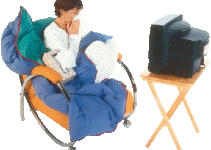Mold is a fungus that grows from spores and also it spreads by spores. If it has the proper conditions, especially moisture and not too much light, mold can be found anywhere, inside or outside of your home. If it finds the optimal conditions, such as humidity, poor ventilation, warm and dark environment, mold can spread quickly.
Mold can appear in different forms and colors such as black, brown, green and can grow on any substrate, including carpets, under windowsills, walls, furniture, ceilings, baseboards, etc.
People exposed to mold may encounter some serious health hazards.
1. Allergic Reactions
Each of us responds differently to allergen factors. Some people are sensitive and for this reason are more affected by exposure to mold.
They may experience various symptoms such as nasal congestion, sneezing, wheezing, coughing, irritated eyes, irritated and itchy skin, fatigue, physical exhaustion and headache. In addition, a prolonged exposure to large amounts of mold can lead to shortness of breath and fever.
Mold problem must be treated seriously and require professional cleaning.
2. Asthmatic Reactions
Exposure to mold is even more dangerous for people with asthmatic problems.
Asthma symptoms get worse and may even become chronic. They range from breathing difficulties to chest pain.
3. Sinus Infections
People who live in a damp, poorly ventilated environment, likely moldy, may have sinus problems. These problems can become over time, chronic sinus infections.
4. Fungal Infections (Mycosis)
Mold is a fungus and that any fungus can cause fungal infection, known as “mycosis”.
The most vulnerable people are those with weak immune systems such as persons doing chemotherapy or persons with HIV or AIDS.
5. Respiratory Problems
It was found that respiratory problems are more frequent and more acute in people exposed to mold. Generally, children are most at risk of developing respiratory diseases.
6. Mycotoxins
Molds produce toxins called mycotoxins. People exposed to mold and especially, to the large amount of mycotoxins may have over time, serious health problems.
The symptoms are manifested by irritated eyes, runny nose, irritated skin, bleeding nose, short and wheezing breathing.
Toxicity of these mycotoxins is very dangerous and can sometimes be harmful and even deadly.
Cleaning and Preventing Mold
If you notice the presence of mold in your home, the first thing you need to do is to clean the mold thoroughly with warm water and bleach.
Caution: Use goggles, gloves and a breathing mask to protect yourself.
Use a hot air blower to dry the affected area. If the wall is compromised, the only solution is to replace the drywall.
Once you clean mold try to find the source of moisture that facilitates this infestation. However, the main solution is to reduce the moisture level from inside of your home below 60%. Repair any leaks that may occur and use a good ventilation.

